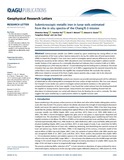| dc.contributor.author | Wang, Zhenchao | |
| dc.contributor.author | Wu, Yunzhao | |
| dc.contributor.author | Blewett, David T. | |
| dc.contributor.author | Cloutis, Edward A. | |
| dc.contributor.author | Zheng, Yongchun | |
| dc.contributor.author | Chen, Jun | |
| dc.date.accessioned | 2018-03-02T17:03:33Z | |
| dc.date.available | 2018-03-02T17:03:33Z | |
| dc.date.issued | 2017-04-22 | |
| dc.identifier.citation | Wang, Z., Y. Wu, D.T. Blewett, E.A. Cloutis, Y. Zheng, and J. Chen. "Submicroscopic metallic iron in lunar soils estimated from the in situ spectra of the Chang’E-3 mission." Geophysical Research Letters 44 (2017): 3485-3492. DOI:10.1002/2017GL072652. | en_US |
| dc.identifier.issn | 0094-8276 | |
| dc.identifier.uri | http://hdl.handle.net/10680/1375 | |
| dc.description.abstract | Submicroscopic metallic iron (SMFe) created by space weathering has strong effects on the optical properties of the lunar surface. Spectra measured in situ by the visible-near-infrared spectrometer (VNIS) on board the Chang’E-3 Yutu rover were used to investigate optical maturity differences at the CE-3 landing site caused by lander exhaust. SMFe abundances were estimated using Hapke’s radiative transfer model. Analysis of the spectrum for a minimally disturbed soil indicates that it contains 0.368 wt % SMFe, corresponding to an Is/FeO maturity index of ~53 and indicating that the landing site is submature. The soil at a location that was more disturbed contains 0.217 wt % SMFe, suggesting that the material removed by the rocket blast is more weathered than the regolith that remained behind. We conclude that maturity differences related to removal of the finest, highly mature particles play a major role in the observed reflectance changes associated with rocket blast. | en_US |
| dc.description.sponsorship | …This research was supported by the National High Technology Research and Development Program of China (863
Program: 2015AA123704), the National Natural Science Foundation of China (41422110 and 41490633), the Science
and Technology Development Fund of Macau (020/2014/A1), and Minor Planet Foundation of Purple Mountain Observatory. The contribution of D.T.B. was made possible by the Chinese Academy of Sciences President’s International Fellowship Initiative, grant 2015VEB057 and by NASA Lunar Data Analysis Program grant NNX16AN55G. E.A.C. thanks NSERC and the Canadian Space Agency for supporting this study. | |
| dc.description.uri | https://agupubs.onlinelibrary.wiley.com/doi/abs/10.1002/2017GL072652 | |
| dc.language.iso | en | en_US |
| dc.publisher | Geophysical Research Letters | en_US |
| dc.rights | info:eu-repo/semantics/openAccess | |
| dc.title | Submicroscopic metallic iron in lunar soils estimated from the in situ spectra of the Chang’E-3 mission | en_US |
| dc.type | Article | en_US |
| dc.identifier.doi | 10.1002/2017GL072652 | |

